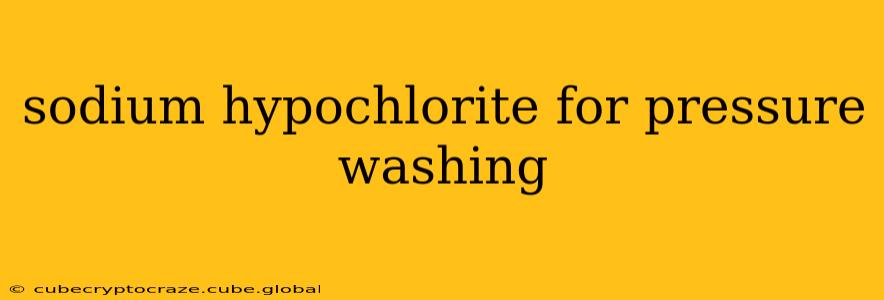Sodium hypochlorite, commonly known as bleach, is a powerful disinfectant often used in pressure washing to sanitize surfaces and remove stubborn stains. While effective, it's crucial to understand its proper application and safety precautions. This guide will delve into the intricacies of using sodium hypochlorite for pressure washing, addressing common questions and concerns.
What is Sodium Hypochlorite and How Does it Work in Pressure Washing?
Sodium hypochlorite is a chemical compound that releases hypochlorous acid when dissolved in water. This acid is a potent oxidizing agent, meaning it readily reacts with organic matter, breaking down stains, mold, mildew, and other contaminants. In pressure washing, the high-pressure water stream combines with the diluted bleach solution to effectively clean and sanitize various surfaces. The oxidizing power of the hypochlorite breaks down the bonds within the stains, allowing the pressure washer to remove them more easily.
What are the Benefits of Using Sodium Hypochlorite in Pressure Washing?
Using sodium hypochlorite in pressure washing offers several key benefits:
- Effective Disinfection: Its potent disinfecting properties eliminate harmful bacteria, viruses, and fungi, making it ideal for sanitizing surfaces like decks, patios, driveways, and even exterior walls.
- Stain Removal: Sodium hypochlorite effectively tackles a wide range of stains, including those caused by mold, mildew, algae, and organic matter.
- Cost-Effective: Bleach is a relatively inexpensive option compared to other commercial cleaning agents with similar disinfecting capabilities.
What are the Risks and Safety Precautions When Using Sodium Hypochlorite for Pressure Washing?
While effective, using sodium hypochlorite requires careful handling due to its corrosive and potentially harmful nature:
- Eye and Skin Irritation: Direct contact can cause severe irritation or burns. Always wear appropriate safety gear, including gloves, eye protection, and protective clothing.
- Respiratory Problems: Inhaling bleach fumes can irritate the respiratory system. Ensure adequate ventilation and consider using a respirator in enclosed spaces.
- Chemical Reactions: Mixing bleach with other cleaning agents, particularly acids, can produce toxic gases. Never mix bleach with ammonia, vinegar, or other cleaning solutions.
- Material Damage: Bleach can damage certain materials, such as some metals and fabrics. Always test a small, inconspicuous area before applying to the entire surface.
How to Safely Use Sodium Hypochlorite for Pressure Washing?
Proper dilution and application are paramount for safe and effective use:
- Dilution: Always dilute sodium hypochlorite according to the manufacturer's instructions. A typical dilution ratio is between 1:10 and 1:100 (bleach to water). Higher concentrations are generally not necessary and can increase the risk of damage.
- Application: Apply the diluted solution to the surface using a low-pressure setting on your pressure washer. Allow the solution to dwell for the recommended time before rinsing thoroughly with clean water.
- Ventilation: Ensure adequate ventilation during application and rinsing to minimize inhalation of fumes.
- Disposal: Dispose of any leftover solution according to local regulations.
What Surfaces are Suitable for Cleaning with Sodium Hypochlorite?
Sodium hypochlorite is suitable for cleaning various surfaces, including:
- Concrete: Driveways, patios, walkways.
- Wood: Decks, fences (ensure the wood is properly sealed and can withstand bleaching).
- Vinyl siding: Test on an inconspicuous area first.
What Surfaces Should You Avoid Cleaning with Sodium Hypochlorite?
Avoid using sodium hypochlorite on:
- Aluminum: It can corrode aluminum surfaces.
- Certain fabrics: Can cause damage or discoloration.
- Sensitive plants: Avoid contact with plants or lawns as it can cause damage.
Can Sodium Hypochlorite Be Used with Other Pressure Washing Detergents?
No, mixing sodium hypochlorite with other cleaning agents can lead to hazardous chemical reactions and should be avoided. Always use it as a stand-alone solution for disinfecting and cleaning.
What are the Environmental Considerations of Using Sodium Hypochlorite?
While effective, sodium hypochlorite is a chemical that can impact the environment. Ensure proper disposal of leftover solutions and avoid runoff into waterways. Consider environmentally friendly alternatives whenever possible.
This guide provides a comprehensive overview of using sodium hypochlorite for pressure washing. Remember to prioritize safety and always follow the manufacturer's instructions. If you have any doubts, consult a professional cleaning service.
